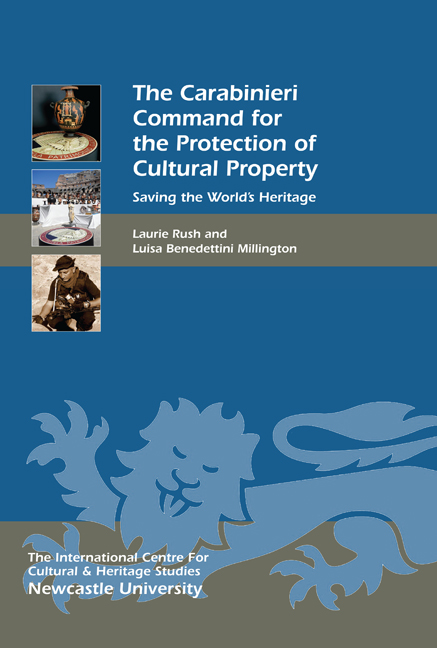Book contents
- Frontmatter
- Contents
- List of Illustrations
- Acknowledgments
- Foreword (in English and in Italian): Brigadier General Mariano Mossa
- Prefazione
- Abbreviations
- 1 The Carabinieri TPC: an Introduction and Brief History. Perché l’Italia? Why Italy?
- 2 Headquarters, the Databank and Operative Department in Rome
- 3 Carabinieri Public Outreach and Education
- 4 Central Italy and the Adriatic: Lazio, Florence, Bologna and Ancona
- 5 Activities in the North: Genova, Monza, Torino and Venezia
- 6 The Regional Offices: Naples, Bari and the South
- 7 The Challenges of the Island Regions: Sicily, Sardinia and the Palermo, Siracusa and Sassari Nuclei
- 8 Investigation Techniques
- 9 Repatriation of Works of Art to Italy: From Siviero to the Medici Conspiracy
- 10 Fakes, Forgeries and Money Laundering
- 11 Who Are the Officers of the Carabinieri TPC?
- 12 The Carabinieri, Peacekeeping and Foreign Relations: The Carabinieri Mission to Iraq
- 13 ‘The Italian Model’
- Bibliography and References
- About the Authors
- Index
- Heritage Matters
5 - Activities in the North: Genova, Monza, Torino and Venezia
Published online by Cambridge University Press: 21 May 2021
- Frontmatter
- Contents
- List of Illustrations
- Acknowledgments
- Foreword (in English and in Italian): Brigadier General Mariano Mossa
- Prefazione
- Abbreviations
- 1 The Carabinieri TPC: an Introduction and Brief History. Perché l’Italia? Why Italy?
- 2 Headquarters, the Databank and Operative Department in Rome
- 3 Carabinieri Public Outreach and Education
- 4 Central Italy and the Adriatic: Lazio, Florence, Bologna and Ancona
- 5 Activities in the North: Genova, Monza, Torino and Venezia
- 6 The Regional Offices: Naples, Bari and the South
- 7 The Challenges of the Island Regions: Sicily, Sardinia and the Palermo, Siracusa and Sassari Nuclei
- 8 Investigation Techniques
- 9 Repatriation of Works of Art to Italy: From Siviero to the Medici Conspiracy
- 10 Fakes, Forgeries and Money Laundering
- 11 Who Are the Officers of the Carabinieri TPC?
- 12 The Carabinieri, Peacekeeping and Foreign Relations: The Carabinieri Mission to Iraq
- 13 ‘The Italian Model’
- Bibliography and References
- About the Authors
- Index
- Heritage Matters
Summary
Carabinieri TPC offices in the North include the Genoa, Monza, Turin and Venice nuclei. The landscape of the northern regions of Italy is immensely varied: from the Italian main plain (Pianura Padana) to the Alps; from large glacial and alpine lakes to the Adriatic Sea; and, of course, many islands. These regions offer spectacular landscapes, as well as profound geographic and historical differences. In the 14th and 15th centuries a series of important independent citystates emerged in the region, among which Genoa, Florence, Milan and Venice became the most powerful. As the city-states declined, Spanish, French and Austrian rulers began to govern the region, creating kingdoms. One kingdom, the Piemonte (Piedmont), was under the control of the Austrian monarchy for centuries. It took many hundreds of years and several wars of independence for these regions to be freed and to become part of the Kingdom of Italy, which was formally born in 1861.
The long history of foreign domination and the relatively recent unification of modern Italy mean that the region is characterised by incredible cultural diversity. Communities along the north-eastern borders can be bilingual, with residents speaking both German and Italian – a reflection of the strength of the shared heritage and traditions. It is not uncommon to travel through the Trentino-Alto Adige region near the Dolomites and realise that the population speaks mainly German rather than Italian. Such diversity leads to an incredible variety of artistic and cultural wealth, making the work of the Carabinieri TPC even harder. The offices in the North have to be prepared for cultural diversity and geographical challenges, as well as overseeing Milan and its surroundings – the largest industrially developed region of Italian territory.
The city of Milan has seen tremendous industrial growth in the last century, expanding outward and engulfing neighbouring cities such as Monza and Segrate. A portion of Segrate has been developed to meet the need for new homes, thus creating what is now known as Milano 2. The population of the Lombardy region where Milan is located reached approximately 3 million in 2012, the second most populated region in Italy, after Rome (Comuni-Italiani.it2012).
- Type
- Chapter
- Information
- The Carabinieri Command for the Protection of Cultural PropertySaving the World's Heritage, pp. 69 - 80Publisher: Boydell & BrewerPrint publication year: 2015



